| Issue |
Ann. Limnol. - Int. J. Lim.
Volume 57, 2021
|
|
|---|---|---|
| Article Number | 11 | |
| Number of page(s) | 10 | |
| DOI | https://doi.org/10.1051/limn/2021008 | |
| Published online | 16 June 2021 | |
Research Article
The effects of Bentagran on the development and antioxidant parameters of Arthrospira platensis Gomont and Chlorella vulgaris Beyerinck (Beijerinck)
1
Biology Department, Adapazarı ENKA School, Sakarya, Turkey
2
Department of Biology, Faculty of Arts and Science, Sakarya University, Sakarya, Turkey
* Corresponding author: sukruye.er@ogr.sakarya.edu.tr
Received:
29
January
2021
Accepted:
28
May
2021
The aim of the study is to determine the effects of Bentagran on growth and oxidative effects to Chlorella vulgaris and Arthrospira platensis and to evaluate the herbicide toxicity on primary producers of aquatic ecosystems. The decrease in both biomass accumulation and chlorophyll-a content in a dose-dependent manner were observed in both organisms exposed to different Bentagran concentrations (for C. vulgaris 60–960 µg mL−1; for A. platensis 100–800 µg mL−1) during 7 days. SOD activity increases significantly in Chlorella vulgaris and Arthrospira platensis at concentrations of 480 and 200 ug mL−1, respectively. Although there was no significant change in APX (ascorbate peroxidase) activity in C. vulgaris, the APX activity decreased at 400 and 600 µg mL−1 concentrations in A. platensis. While the GR (glutathione reductase) activity increased at 960 µg mL−1 concentration in C. vulgaris, it also showed increases at 100, 200 and 400 μg mL−1 concentrations, but it decreased at 600 µg mL−1 concentration in A. platensis. MDA (malondialdehyde) and proline amounts decreased only at the concentration of 960 µg mL−1, while H2O2 didn't change compared to control. Total MDA, H2O2 (hydrogen peroxide) and proline amounts did not show significant change compared to control. It is found that the effects of Bentagran on growth and antioxidant parameters are diverse at different concentrations and species, and this can be attributed to the different reactive oxygen species (ROS) production ability in these species.
Key words: Microbial ecotoxicology / microalgae / cyanobacteria / herbicide / bentazone / antioxidant enzyme
© EDP Sciences, 2021
1 Introduction
The effects of pesticide derivatives on animal and plant biodiversity reach undesirable levels in aquatic ecosystems as well as in terrestrial environments (Mahmood et al., 2016). Being pesticide derivatives used in the applications against unwanted plants, herbicides may enter into aquatic ecosystems when their heavy usage in agriculture and horticulture (DeLorenzo et al., 2001; Ma et al., 2010; Silva et al., 2019). Algae are important inhabitants of aquatic ecosystems, with their ability to accumulate, detoxify, or metabolize herbicide (DeLorenzo et al., 2001; Sehrawat et al., 2021). Chlorella vulgaris, an eukaryotic algae with great biodiversity, attracts attention with its properties such as the purification of heavy metals, nitrogen, and phosphorus compounds (Znad et al., 2018). It is also produced for commercial food supply. Arthrospira platensis, a gram-negative, prokaryotic, non-toxic cyanobacterium and it has widespread usage in the commercial world (Tunca et al., 2021). Species of Arthrospira have also been determined in the flora of Turkey (Aysel, 2005).
When aquatic producer organisms are exposed to different kinds of stresses like herbicides, light, or limited nutrients, they use defense mechanisms according to natural conditions. These kinds of different stress factors have the potential to increase the production of ROS. This production displays the oxidative stress levels in organisms (Arora et al., 2002).
Antioxidant defense system (ADS) responses are important to determine the stress responses of an organism to physical and chemical stimuli and to evaluate the organism's tolerance to these stress conditions. Organisms developed the ADS to control the formation of free radicals and to prevent the harmful effects of these molecules. ADS include chemicals such as tocopherols, ascorbic acid, glutathione, which neutralize free radicals or enzymes such as superoxide dismutase (SOD; E.C 1.15.1.1: the code in enzyme nomenclature), ascorbate peroxidase (APX; E.C 1.11.1.11: the code in enzyme nomenclature), and glutathione reductase (GR; E.C 1.8.1.7: the code in enzyme nomenclature). SOD is the first and major detoxification enzyme. It is the most powerful antioxidant and works as a radical scavenger in cells (Ighodaro and Akinloye, 2018). SOD is involved in the prevention of lipid peroxidation (Altınışık, 2000) By catalyzing the reaction that forms hydrogen peroxide (H2O2) and molecular oxygen (O2) from superoxide radicals (Doğru and Demirtaş, 2021), it makes the superoxide anion less harmful (Ighodaro and Akinloye, 2018). On the other hand, still toxic H2O2 is present and should be transformed to H2O in subsequent reactions. The series of reactions to remove H2O2 are known as the Ascorbate-Glutathione cycle or the Halliwell-Asada pathway (Avashthi et al., 2018). APX plays a role to scavenge the H2O2 by using ascorbate as the electron donor (Bajguz, 2010). GR, which is a member of flavoenzyme family, catalyzes the NADPH-dependent reduction of glutathione disulphide (GSSG) to glutathione (GSH) (Verma and Dubey, 2003). The key factor for the oxidative balance of the cell is the ratio of GSSG/GSH produced in the cell. Moreover, high levels of the reduced glutathione and a low level of the oxidized glutathione disulfide are also important for maintaining the cell. Therefore, ascorbate and glutathione are not consumed; and the net electron flow is from NADPH to H2O2 (Noctor and Foyer, 1998; Doğru, 2021). MDA is an aldehyde metabolite that constitutes the last product in lipid peroxidation and it shows the level of oxidative damage (Urso and Clarkson, 2003). At the same time, increasing MDA concentration indicates an increase in the capacity of free radical production in the microorganism (Choudhary et al., 2007). Another defense amino acid produced by plants against lipid peroxidation under stress conditions is proline. There is evidence that proline is very important in capturing ROS against stress-induced oxidative stress caused by abiotic factors (Kaul et al., 2008). There are some studies in the literature about oxidative stress caused by herbicide in algae. Wang et al. (2021) reported that glyphosate caused oxidaitive stress on Microcystis aeruginosa at concentrations between 0 and 5 mg L−1. Majewska et al. (2021) found that treatment with atrazine caused an increase in the ascorbate peroxidase levels but Diclofenac treatment drastically reduced in Chlamydomonas reinhardtii. Machado and Soares (2021) observed that metolachlor caused ROS overproduction and decline of the antioxidant system Pseudokirchneriella subcapitata at 0–35 μg mL−1.
The Bentagran, and its active ingredient ‘Bentazone’ which is a non-selective and recently emerging broad-spectrum herbicide, is used to control many broadleaf weeds and reeds in soybeans, alfalfa, pepper, asparagus, sorghum, grass, rice, corn, peanuts, mint, dried beans, and fleshy lima beans (Galhano et al., 2011). Researches have shown that bentazone, which has a very high solubility in water, is generally not easily absorbed by the soil and therefore enters adjacent freshwater ecosystems and eventually moves towards the river and sea waters (Boesten and Pas, 2000). Therefore, it attracts attention as a pollutant in underground and surface waters in Portugal and other European countries (Galhano et al., 2011). Moreover, it is used in most parts of the world, including North Africa, New Zealand, India, the Philippines, North America, Australia, and Europe (Galhano et al., 2011). Although it is found in groundwater and it shows a high affinity for water components, it does not accumulate in nature and the risk of exposure due to food is low. In the pesticide risk index assessment performed by Solomon (1997), bentazone was classified as a less harmful pesticide (Macedo et al., 2008). Marques et al. (2011) reported that the level of chlorophyll-a content reduced by Bentagran toxicity in P. subcapitata. Tomé (1996) showed that high Bentagran caused toxic effects to Nostoc sp. Munkegaard et al. (2008) studied with bentazone combination with other herbicides on Pseudokirchneriella subcapitata and they observed the toxic effects on algae. Galhano et al. (2010), Galhano et al. (2011), and Bagchi et al. (2012) reported that Bentagran caused the oxidative stress on Anabaena cylindrica and Nostoc muscorum, Synechococcus elongatus PCC7942, respectively.
The object of the present study was to describe herbicide toxicity to aquatic microorganisms. Being herbicide nature, Bentagran can exhibit similar properties in unicellular organisms as plants containing chlorophyll due to its photosynthetic inhibition mechanisms and hydrogen peroxide accumulation potential. However, the preservation of the chlorophyll structure and the levels of oxidative stress production can vary according to organism. In the literature, certain algae species have been studied with bentazone and Bentagran, but there is no comparison between algae species. For this reason, the hypothesis of the study is that Bentagran herbicide have different effects on growth and oxidative stress due to different cell structure and detoxification mechanisms in prokaryotic and unicellular eukaryotic algae. In this study, the effects of Bentagran on C. vulgaris and A. platensis were evaluated in terms of the growth rate (OD750; Optic Density 750), chlorophyll-a content, and enzymatic (SOD, APX, and GR) and non-enzymatic (MDA, proline, and H2O2 amounts) parameters.
2 Materials and methods
2.1 Algae culture and treatment
A. platensis-M2 was obtained from the Soley Microalgae Institute (California, USA) (Culture collection No: SLSP01) and C. vulgaris was obtained from Çukurova University, Faculty of Fisheries. The Bentagran herbicide [3–(1–methyl ethyl) − 1H − 2,1,3 − benzothiadiazine − 4 (3H)- one 2,2–dioxide] was used in this study (CAS No: 25057-89-0, 480 g/L, ≥95% purity, Bentazone EC, İstanbul, Turkey). A. platensis was grown in Spirulina Medium (18 g Na2CO3, 1 g NaCO3, 1 g K2HPO4, 2g NaNO3, 1 g KSO4, 1 g NaCl, 0.4 g MgSO4.7H2O, 0.02 g FeSO4.7H2O, 0.02 g CaCl2.2H2O in L; Sigma-Aldrich) (Aiba and Ogawa, 1977), while C. vulgaris was grown in BG11 (1.5 g NaNO3, 1 g NaHCO3, 0.2 mL, K2HPO4 1 M, 10 mL BG11c; Sigma-Aldrich) (Rippka et al., 1979) under axenic conditions. 20 mL algal culture was inoculated to 180 mL culture medium in an Erlenmeyer flask and was allowed to grow for 10 days under the conditions of 93 µmol photons m−2 s−1 photosynthetically available radiation in 12:12 h light/ dark cycle at 30 ± 1 °C for A. platensis and 25 ± 1 °C for C. vulgaris using the growth chamber (Biobase BJPX-A25011) At the end of 10 days, cultures were renewed and all the flasks contained 50 mL algal culture. Various concentrations of Bentagran compound for C. vulgaris (60, 120, 240, 480, 960 µg mL−1) and A. platensis (100, 200, 400, 600, and 800 µg mL−1) were added to the culture medium. The range of concentrations was determined with preliminary range-finding bioassays according to EC50 value for growth parameters.
2.2 Cell growth assay
Optic density (OD) of microalgae was measured spectrophotometrically over 7 days under control and stressed conditions taking absorbance at 750 nm. Chlorophyll-a contents were estimated by methanol extraction and measured spectrophotometrically (Shimadzu UVmini 1240 spectrophotometer) taking absorbance at 665 nm for 7 days (MacKinney, 1941).
2.3 Antioxidant enzyme activities
After 7 days, 2 mL culture solutions from the control and each Bentagran-exposed algae medium was centrifuged (Centrution Scientific K3 series) at 15 000 rpm for 20 min. at 4 °C and resulting pellets were kept at −20 °C until enzyme activity measurements. The protein concentration of the algal cell extracts was determined according to Bradford (1976), using BSA (bovine serum albumin; Sigma-Aldrich) as a standard.
SOD activity was determined by the assay of Beyer and Fridovich (1987) but it was modified according to Kılıç et al. (2019). 0.2 g of pellet was suspended in homogenization buffer (1.5 mL) containing 100 mM K2HPO4 buffer (pH 7.0), 1 mM Na2EDTA (Sigma-Aldrich), and 2% PVP (Sigma-Aldrich). The enzyme extract was obtained after centrifugation at 18 800 g for 20 min at 4 °C and it was used in the reaction mixture included of 100 mM K2HPO4 buffer (pH 7.8) containing 9.9 × 10−3 M methionine (Applichem), 5.7 ×10−5 M NBT (Applichem), %1 triton X‐100 (Sigma-Aldrich). The reaction was started by the addition of 0.9 µM riboflavin (MP Biomedicals) and the mixture was exposed to light with an intensity of 375 µmol m−2 s−1. After 15 min, the absorbance was read at 560 nm. SOD activity was calculated by a standard graphic and expressed as unit mg−1 protein.
Glutathione reductase activity was measured with the method of Sgherri et al. (1994) but it was modified according to Kılıç et al. (2019). 0.2g of pellet was suspended in homogenization buffer (1.5 mL) containing 100 mM KH2PO4 buffer (pH 7.0), 1 mM Na2EDTA, and 2% PVP. The enzyme extract was obtained after centrifugation at 18 800 g for 20 min at 4 °C and enzyme extract containing 100 µg protein was added to the reaction mixture included 100 mM KH2PO4 buffer (pH 7.8), 2 mM Na2EDTA, 0.5 mM oxidized glutathione (GSSG; Applichem), 0.2 mM NADPH (Sigma-Aldrich) and total volume was 1 mL. The decrease in absorbance at 340 nm was recorded. The correction was made for the non‐enzymatic oxidation of NADPH by recording the decrease at 340 nm without adding GSSG to assay mixture. The enzyme activity was calculated from the initial rate of the reaction after subtracting the non‐enzymatic oxidation using the extinction coefficient of NADPH (E = 6.2 mM cm−1 at 340 nm).
Ascorbate peroxidase (APX; EC 1.11.1.11) activity was determined with the method of Wang et al. (1991) but it was modified according to Kılıç et al., 2019. APX extraction was conducted in 50 mM Tris–HCl (pH 7.2; Sigma-Aldrich), 2% PVP, 1 mM Na2EDTA, and 2 mM ascorbate. The enzyme extract was obtained after centrifugation at 18 800 g for 20 min at 4 °C and enzyme extract containing 100 µg protein was used in the reaction mixture included of 50 mM KH2PO4 buffer (pH 6.6), 2.5 mM ascorbate, and 10 mM H2O2 in a final volume of 1 mL. The enzyme activity was calculated from initial rate of the reaction using the extinction coefficient of ascorbate (E = 2.8 mM cm−1 at 290 nm).
2.4 Non enzymatic parameters
The amount of malondialdehyde was determined according to the method used by Heath and Packer (1968). 0.2 g of the pellet was homogenized in 3 mL of 0.1% Trichloroacetic acid (TCA) (4 °C) and was centrifuged at 4100 rpm for 15 min and the supernatant was used in the subsequent determination. 0.5 mL of 0.1 M Tris − HCl (pH 7.6) and 1 mL of TCA − TBA − HCl reagent (15% w/v) (Trichloroacetic acid −0.375% w/v, Sigma-Aldrich; Thiobarbituric acid, Sigma-Aldrich; 0.25 N Hydrochloric acid, Merck) were added into the 0.5 mL of the supernatant. The mixture was heated at 95 °C for 30 min. and then quickly cooled in an ice bath. To remove suspended turbidity, the mixture was centrifuged at 4100 rpm for 15 min, and then the absorbance of the supernatant at 532 nm was recorded. Non-specific absorbance at 600 nm was measured and subtracted from absorbance at 532 nm. The MDA content was calculated using the extinction coefficient of 155 mM−1 cm−1. For determination of H2O2 content, 0.5 mL of 0.1 M Tris-HCl (pH 7.6) and 1 mL of 1 M Potassium iodide (KI, Sigma-Aldrich) were added to 0.5 mL of supernatant. After 90 min., the absorbance was recorded at 390 nm. To determine the amount of proline, the method of Weimberg (1987) was followed. 0.1 g of the pellet was homogenized with 10 mL of 3% aqueous sulphosalicylic acid and the homogenates were incubated in a hot water bath at 95 °C for 30 min. The samples were then cooled and centrifuged at 4100 rpm for 10 min. 2 mL of the extract reacted with 2 mL of acid-ninhydrine and 2 mL of glacial acetic acid (Merck) for 1 h at 100 °C. The reaction mixture was extracted with 4 mL toluene. The chromophore containing toluene (Sigma-Aldrich) was separated and the absorbance was recorded at 520 nm.
2.5 Statistical analysis
The experimental design was performed within three independent replicates for each treatment. The EC50 value was calculated with Origin Pro 8.5 program. The homogeneity test was performed on the data with IBM SPSS Statistics 20 program. The differences between the control and treated samples were analyzed by one-way ANOVA at a 95% confidence level, according to Tukey using the SPSS 20.0 statistical program for Windows.
The mean values ± SE were given in Figures.
3 Results
3.1 Biomass and chlorophyll-α content
OD750 (Optical Density at 750 nm) measurements and chlorophyll-α content in C. vulgaris and A. platensis cultures treated with different Bentagran concentrations are presented in Figures 1 and 2, respectively. Bentagran added to the culture medium for 7 days caused a significant decrease in both biomass accumulation and chlorophyll-a content in C. vulgaris and A. platensis cells in a dose-dependent manner. It has been found that the highest Bentagran concentrations (960 μg mL−1 for C. vulgaris and 800 μg mL−1 for A. platensis) lead to the most significant reduction in biomass accumulation and chlorophyll-a content. Besides, it was found that the biomass accumulation in A. platensis cells increased progressively after 2nd day; chlorophyll-a content in A. platensis cells increased after 3rd day in a time-dependent manner. However, the biomass accumulation in C. vulgaris were significantly reduced by Bentagran concentrations on the 2nd day of the application, chlorophyll-a content in C. vulgaris cells reduced by Bentagran concentrations on the 7th day of the application. The half-maximal effective concentration (EC50) values were 854.94 µg mL−1 for Arthrospira platensis and 739.44 µg mL−1 for Chlorella vulgaris on 7th day.
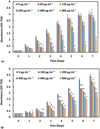 |
Fig. 1 Changes of OD 750 values in (a) C. vulgaris and (b) A. platensis algae by adding different concentrations of Bentagran herbicide for 7 days. Data are means ±SD of three replicates. Mean values in columns with asterisk are significantly different at the 5% level according to least significant differences (Tukey) Test. |
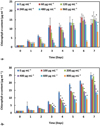 |
Fig. 2 Changes in the amounts of chlorophyll-a in (a) C. vulgaris and (b) A. platensis algae by adding different concentrations of Bentagran herbicide for 7 days. Data are means ±SD of three replicates. Mean values in columns with asterisk are significantly different at the 5% level according to least significant differences (Tukey) Test. |
3.2 Antioxidant enzyme activities
The activity of SOD significantly increased (674.68%) at 480 µg mL−1 concentration in C. vulgaris cultures, while increased (166.39%) at 200 µg mL−1 concentrations in A. platensis cultures (p < 0.05) (Fig. 3). APX activity of C. vulgaris cultures did not show a significant change compared to control. However, it decreased at 400 (28.74%) and 600 (31.97%) µg mL−1 concentrations in A. platensis cultures (p < 0.05) (Fig. 4). The activity of GR increased (118.15%) at 960 µg mL−1 in C. vulgaris cultures, while it increased at 100 (47.61%), 200 (15.50%), and 400 (31.34%) µg mL−1 concentrations in A. platensis cultures (p < 0.05). On the other hand, GR activity decreased (15.05%) at 600 µg mL−1 concentrations in A. platensis cultures (Fig. 5).
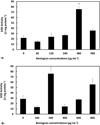 |
Fig. 3 Changes in SOD activities of (a) C. vulgaris and (b) A. platensis by adding different concentrations of Bentagran herbicide. Data are the means ± SD of three replicates. Mean values in columns with asterisk are significantly different at the 5% level according to least significant differences (Tukey) Test. |
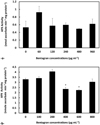 |
Fig. 4 Changes in APX activities of (a) C. vulgaris and (b) A. platensis by adding different concentrations of Bentagran herbicide. Data are the means ± SD of three replicates. Mean values in columns with asterisk are significantly different at the 5% level according to least significant differences (Tukey) Test. |
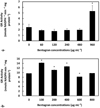 |
Fig. 5 Changes in GR activities of (a) C. vulgaris and (b) A. platensis by adding different concentrations of Bentagran herbicide. Data are the means ± SD of three replicates. Mean values in columns with asterisk are significantly different at the 5% level according to least significant differences (Tukey) Test. |
3.3 Non-enzymatic parameters
C. vulgaris and A. platensis cultures did not show a significant change compared to control in the amount of H2O2 (Fig. 6). The amount of MDA decreased (73.71%) significantly at 960 µg mL−1 concentration in C. vulgaris cultures (p < 0.05), while A. platensis cultures did not show a significant change (Fig. 7). On the other hand, free proline content also decreased (85.59%) significantly at 960 µg mL−1 concentration in C. vulgaris cultures (p < 0.05). Furthermore, the free proline content of A. platensis cultures did not show a significant change compared to control (p < 0.05) (Fig. 8).
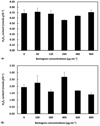 |
Fig. 6 Changes in amounts of H2O2 of (a) C. vulgaris and (b) A. platensis by adding different concentrations of Bentagran herbicide. Data are the means ± SD of three replicates. Mean values in columns with asterisk are significantly different at the 5% level according to least significant differences (Tukey) Test. |
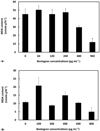 |
Fig. 7 Changes in amounts of MDA of (a) C. vulgaris and (b) A. platensis by adding different concentrations of Bentagran herbicide. Data are the means ± SD of three replicates. Mean values in columns with asterisk are significantly different at the 5% level according to least significant differences (Tukey) Test. |
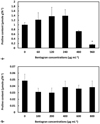 |
Fig. 8 Changes in amounts of Proline of (a) C. vulgaris and (b) A. platensis by adding different concentrations of Bentagran herbicide. Data are the means ± SD of three replicates. Mean values in columns with asterisk are significantly different at the 5% level according to least significant differences (Tukey) Test. |
4 Discussion
In the study, Bentagran herbicide significantly affects the growth rate for both algae, for 7 days. The EC50 values were 854.94 µg mL−1 for Arthrospira platensis and 739.44 µg mL−1 for Chlorella vulgaris according to growth rate. Cedergreen and Streibig (2005) and Munkegaard et al. (2008) measured the EC50 value of bentazone in Pseudokirchneriella subcapitata as 13.6 mg L−1 and 51 mg L−1, respectively. Macedo et al. (2008) calculated the EC50 value as 13.0 mg L−1 for Skeletonema costatum. Hourmant et al. (2009) found the value as 150 mg L−1 for Chaetoceros gracilis. When these studies are compared, even the closest dose is much lower than in our study results. The reason may arise from since the selected algae are in different divisions. In addition, the recent study in Ebro River Delta has reported the content of bentazone as 180 µg mL−1 in aquatic ecosystems (Barbieri et al., 2021). Because of the excessive herbicide usage, it is thought that there will be serious damage to the environment in the future and the algal growths are threatened in such systems.
The reductions in the growth rate are more than the decrease of the chlorophyll-a production, especially in Chlorella vulgaris. Pesticides affect mitotic division stages by prevention of macromolecule synthesis and microtubule formation, thus they inhibit the algal growth rates (Cedergreen and Streibig, 2005). It is predicted that these processes occur more rapidly than disruption of chlorophyll-a synthesis and the inhibition of photosynthetic reactions. Bentagran acts also as an inhibitor in photosynthesis reactions by blocking the electron transfer flow in photosystem II (PS II) and CO2 fixation. In the presence of light, blocking of PS II induced by Bentagran leads to secondary reactions such as interruption of energy flow and formation of various ROS like superoxide radicals (Macedo et al., 2008). Marques et al. (2011) examined the effects of herbicide pollution on microalgae Pseudokirchneriella subcapitata in drainage channels of Portuguese rice fields. They reported a reduced level of chlorophyll-a content in P. subcapitata due to Bentagran toxicity. Moreover, Tomé (1996) showed that high Bentagran concentrations caused a reduction in the chlorophyll-a content of cyanobacteria Nostoc sp. Following these studies, our research has demonstrated that the chlorophyll-a content in C. vulgaris and A. platensis cells were reduced in a dose-dependent manner as a result of Bentagran toxicity. Similar to other toxic matter (Prasad and Strzałka, 1999; Surosz and Palinska, 2004; Schoefs and Bertrand, 2005; Günsel et al., 2018), this herbicide can be effective in the enzymatic inhibition of chlorophyll biosynthesis and/or accelerated degradation of photosynthetic pigments, or disruption of thylakoid integrity. Due to the effects on pigment degradation and photosynthetic inhibition, Bentagran may have suppressed the growth of C. vulgaris and A. platensis.
The intervention of the Bentagran in such photosynthetic processes is thought to be due to the formation of ROS in redox reactions. This situation causes oxidative stress in cells and creates an imbalance between membrane structure and antioxidant systems (Kortekamp, 2011). The activity of SOD increased only at 480 µg mL−1 in C. vulgaris when exposed to different concentrations of Bentagran. Also, 200 μg mL−1 concentrations showed a significant increase compared to the control in A. platensis. Galhano et al. (2010) studied the effect of Bentagran on Anabaena cylindrica antioxidant defense system. In their study, they observed that SOD activity increased due to increasing concentrations of Bentagran. Moreover, Galhano et al. (2011) showed that SOD activity increases when applying Bentagran on Nostoc muscorum. Moreover, in the strain of Synechococcus elongatus PCC7942 which is exposed to Bentagran, the activity of SOD increased 2–3-fold (Bagchi et al., 2012). The SOD is an important endogenous antioxidant enzyme that functions as the first detoxification enzyme in cells and part of the primary defense system against ROS (Ighodaro and Akinloye, 2018). Kong et al. (1999) showed as the rate of contamination in algal cells increases the cellular detoxification system and SOD synthesis begins, thus it acts as the key enzyme that destroys active oxygen. Therefore, the SOD enzyme can be used as a sensitive biomarker and an early stimulus of pollution (Li et al., 2005).
Ascorbate peroxidase (APX) and glutathione reductase (GR) are enzymes produced mainly in chloroplasts and other cell organelles that remove H2O2 and protect the redox state of the cell. Increased activity of these enzymes indicates cellular stress. Ascorbate is the most important reducing substrate in the detoxification of H2O2 in plant cells and it is broken down by APX into H2O (Koç and Üstün, 2008). In our study with C. vulgaris, although APX activity increased compared to control, this increase was not statistically significant. The unchanged APX activity and unchanged H2O2 content similarity arise from the enzyme-substrate relationship in C. vulgaris application.
The ascorbate-glutathione cycle is a defense mechanism that provides detoxification of H2O2 to water and oxygen without generating ROS and is also present in peroxisome, chloroplast, cytosol, and mitochondria (Doğru, 2019). GR activity of C. vulgaris cultures exposed to Bentagran increased only at 960 µg mL−1 concentration indicating that this dose is the critical concentration for cellular damage. Although GR and APX enzymes are key enzymes related to each other, some studies have revealed that increases in glutathione pool and GR activity do not cause any increase in ascorbate levels under stress conditions. As the increase in ascorbate level is related to APX activity, this situation is also seen in our study (Karpuz and Çakır, 2021).
In A. platensis cultures, the activity of APX decreased at 400 and 600 µg mL−1 concentrations. GR is required for the regeneration of ascorbate (Günsel et al., 2018), and the activity of APX is related to the ascorbate and H2O2 contents present in the medium.
The GR activity increased compared to the control in A. platensis cultures exposed to Bentagran at 100, 200, and 400 µg mL−1 concentration. Das and Bagchi (2012) reported that GPX-GR activity increase by 60% when applying Bentagran on mutant S. elongatus PCC7942 strain. It has been observed that GR activity increases as a defense strategy. It is thought that the decrease of GR activity in increasing concentrations affects the GSH pool which will form the substrate for GR activity thus suppressing the conversion of GSH to GSSG (Galhano et al., 2010).
Both GR activity and APX activity decreased at 600 µg mL−1 concentrations but they did not change at 800 µg mL−1 concentrations in Bentagran application. The most important question is, why the activities increased at this concentration, at this point. Probably, the herbicide consumed the enzyme up to 600 µg mL−1 concentrations in the cell but the gene expression of these enzymes was triggered at the 800 µg mL−1 concentrations. Molecular analyzes are recommended to understand this issue.
In our study, the alterations of GR activity support the changes of APX activity at similar concentrations in these pesticide applications because the ascorbate pool is stabilized by the GR enzyme. It has been reported in previous studies that GR enzyme is associated with APX activity (Mallick and Rai, 1999; Teisseire and Vernet, 2001).
MDA is one of the major products of lipid peroxidation, which is associated with oxidative stress in cells. Total MDA amounts of C. vulgaris cultures decreased only at 960 µg mL−1 concentration compared to the control. Increased GR activity has supported this information and also proline content has decreased at this concentration.
H2O2 is a strong oxidant that rapidly oxidizes thiol groups. Since photosynthesis is associated with thiol-regulating enzymes, H2O2 should not be allowed to accumulate in chloroplasts (Koç and Üstün, 2008). Total H2O2 content did not show significant change compared to control in C. vulgaris cultures exposed to increasing concentrations of Bentagran. The unchanged H2O2 content was supported by an increase in GR activity. Das and Bagchi (2012) observed that cell growth on the mutant S. elongatus PCC7942 strain was five times faster than that of wild type in Bentagran studies. They reported they achieved this with the H2O2 detoxification mechanism and thus limited lipid peroxidation was observed. Galhano et al. (2010) reported H2O2 was removed by GR-GSH, CAT, and APX enzymes in A. cylindrica which they applied Bentazone. In our study, this situation can be explained by SOD and APX activities. Because if the SOD and APX activities decrease or increase, this situation reflects the H2O2 content. APX activity determines the H2O2 accumulation in cells and plays an important role (Asada, 1992). In this context, H2O2 accumulation was prevented in the medium because of the increase in the SOD and APX activity of A. platensis at 200 and 800 µg mL−1 concentrations.
On the other hand, the total MDA content did not show significant change compared to control in A. platensis cultures exposed to all applied Bentagran concentrations. These changes are related to the changes in the amount of H2O2. When Lin and Kao (2000) applied the salt stress on Oryza sativa plant, they reported the unchanged content of both H2O2 and MDA due to the activity of other antioxidant enzymes.
While the free proline content decreased to the highest concentration of 960 µg mL−1 in C. vulgaris cultures, the content did not change compared to the control in any concentrations of A. platensis treatment. Although there are studies in the literature that proline content increases under stress conditions, reverse studies are also available. Arthrospira platensis has decreased its proline content with increasing concentration of deltamethrin (Tunca et al., 2021). In this study, they have suggested that sulfite inhibited the proline dehydrogenase enzyme in proline synthesis. Similarly, in our study, proline depletion may be an indication that toxic substances accumulate in the medium, proline synthesis may be inhibited and proline structure may be impaired. Furthermore, the decreased proline content suggests the possibility that free proline was used by free radicals. It is known that pesticide-acting proline production is almost absent in cyanobacteria (Galhano et al., 2010). Moreover, when the changes in the proline content and the changes in H2O2 and MDA amounts are examined, the results suggest proline may prevent cell membrane damage and increase MDA amount. It has been shown that cadmium application does not change the MDA content and free radical damage has been prevented in the cell because proline has acted as an antioxidant in transgenic Chlamydomonas reinhardtii (Siripornadulsil et al., 2002). The similarity between SOD and GR-APX enzyme activities can be supported by the fact that they perform good teamwork against lipid peroxidation in cells, and that there is no increase in the amount of MDA and proline, which are the indicators of lipid peroxidation in C. vulgaris cultures.
As a result, Bentagran herbicide reduces growth rates and causes oxidative damage by creating similar effects in both algae, despite the different cell structures. When EC 50 values are compared, the concentration in the treatment of Chlorella vulgaris has a higher value than in the Arthrospira platensis application, but the values are close to each other. This situation arises from the similarity of accumulation, detoxification, and degradation processes of Bentagran herbicide, in both algae. However, when the results are examined in detail, the antioxidant responses are different from each other. It is predicted that the most important reason of the case is the different free radicals amount produced by chloroplasts and mitochondria being important sources of ROS, in C. vulgaris. For this reason, different rates were observed in both algae especially in SOD and GR activities and in MDA amounts. Bentagran creates oxidative stress in phototrophs of aquatic ecosystems. The use of these small organisms, compared to large plants, in the detection of herbicidal contamination of the environment will shed light on further studies.
References
- Aiba S, Ogawa T. 1977. Assessment of growth yield of a blue-green alga, Spirulina platensis, in axenic and continuous culture. J Gen Microbiol 102: 179–182. [Google Scholar]
- Altınışık M. 2000. Serbest oksijen radikalleri ve antioksidanlar. Aydın Tıp Fakültesi, Biyokimya Ders Notları. [Google Scholar]
- Arora A, Sairam RK, Srivastava GC. 2002. Oxidative stress and antioxidative system in plants. Curr Sci 82: 1227–1238. [Google Scholar]
- Asada K. 1992. Ascorbate peroxidase-hydrogen peroxide-scavenging enzyme in plants. Physiol Plant 85: 235–241. [Google Scholar]
- Avashthi H, Pathak RK, Pandey N, Arora S, Mishra AK, Gupta VK, Ramteke PW, Kumar A. 2018. Transcriptome-wide identification of genes involved in Ascorbate–Glutathione cycle (Halliwell–Asada pathway) and related pathway for elucidating its role in antioxidative potential in finger millet (Eleusine coracana (L.)). Biotechnology 8: 1–18. [Google Scholar]
- Aysel V. 2005. Check-list of the freshwater algae of Turkey. J Black Sea/Medit Environ 11: 1–124. [Google Scholar]
- Bagchi SN, Das PK, Banerjee S, Saggu M, Bagchi D. 2012. A bentazone-resistant mutant of cyanobacterium, Synechococcus elongatus PCC7942 adapts different strategies to counteract on bromoxynil- and salt-mediated oxidative stress. Physiol. Mol. Biol. Plant. 18: 115–123. [Google Scholar]
- Bajguz A. 2010. An enhancing effect of exogenous brassinolide on the growth and antioxidant activity in Chlorella vulgaris cultures under heavy metals stress. Environ Exper Bot 68: 175–179. [Google Scholar]
- Barbieri MV, Peris A, Postigo C, Moya-Garcés A, Monllor-Alcaraz LS, Rambla-Alegre M, de Alda ML. 2021. Evaluation of the occurrence and fate of pesticides in a typical Mediterranean delta ecosystem (EBRO RIVER delta) and risk assessment for aquatic organisms. Environ Poll 274: 115813. [Google Scholar]
- Beyer WF, Fridovich I. 1987. Assaying for superoxide dismutase activity: some large cobsequences of minor changes in conditions. Anal Biochem 161: 559–566. [Google Scholar]
- Boesten JJTI, Van der Pas LJT. 2000. Movement of water, bromide and the pesticides ethoprophos and bentazone in a sandy soil: the Vredepeel data set. Agric Water Manage 44: 21–42. [Google Scholar]
- Bradford MM. 1976. A rapid and sensitive method for the quantitation of microgram quantities of protein utilizing the principle of protein-dye binding. Anal Biochem 72: 248–254. [Google Scholar]
- Cedergreen N, Streibig JC. 2005. The toxicity of herbicides to non‐target aquatic plants and algae: assessment of predictive factors and hazard. Pest Manage Sci 61: 1152–1160. [Google Scholar]
- Choudhary M, Jetley UK, Khan MA, Zutshi S, Fatma T. 2007. Effect of heavy metal stress on proline, malondialdehyde, and superoxide dismutase activity in the cyanobacterium Spirulina platensis-S5. Ecotoxicol Environ Safe 66: 204–209. [Google Scholar]
- Das PK, Bagchi SN. 2012. Role of bacterioferritin comigratory protein and glutathione peroxidase-reductase system in promoting bentazone tolerance in a mutant of Synechococcus elongatus PCC7942. Protoplasma 249: 65–74. [Google Scholar]
- DeLorenzo ME, Scott GI, Ross PE. 2001. Toxicity of pesticides to aquatic microorganisms: a review. Environ Toxicol Chem 20: 84–98. [Google Scholar]
- Doğru A. 2019. Antioxidant systems in plants and responses to salt stress. IJEASED 1: 164–185. [Google Scholar]
- Doğru A. 2021. Hıyar (Cucumis sativus L.) Bitkisinin Yüksek Sıcaklık Stresine Verdiği Antioksidant Cevaplar. Turk J Agric Res 8: 42–48 (in Turkish). [Google Scholar]
- Doğru A, Demirtaş E. 2021. Exogenous potassium nitrate alleviates salt-induced oxidative stress in maize. Eur J Biol Res 11: 24–33. [Google Scholar]
- Galhano V, Peixoto F, Gomes‐Laranjo J. 2010. Bentazon triggers the promotion of oxidative damage in the Portuguese ricefield cyanobacterium Anabaena cylindrica: response of the antioxidant system. Environ Toxicol 25: 517–526. [Google Scholar]
- Galhano V, Santosa H, Olibeirab MN, Gomes-Laranjoa J, Peixotoc F. 2011. Changes in fatty acid profile and antioxidant systems in a Nostoc muscorum strain exposed to the herbicide bentazon. Process Biochem 46: 2152–2162. [Google Scholar]
- Günsel A, Tunca H, Bilgiçli AT, Doğru A, Yarasir MN, Sevindik TO, Er Ş. 2018. The effects of a water-soluble alpha tetra-substituted zinc phthalocyanine derivative on Arthrospira platensis − M2 strain. J Porphyr Phthalocyanines 22: 686–692. [Google Scholar]
- Heath RL, Packer L. 1968. Photoperoxidation in isolated chloroplasts: I. Kinetics and stoichiometry of fatty acid peroxidation. Arch Biochem Biophys 125: 189–198. [Google Scholar]
- Hourmant A, Amara A, Pouline P, Durand G, Arzul G, Quiniou F. 2009. Effect of bentazon on growth and physiological responses of marine diatom: Chaetoceros gracilis. Toxicol Mechan Methods 19: 109–115. [Google Scholar]
- Ighodaro OA, Akinloye OA. 2018. First line defence antioxidants-superoxide dismutase (SOD), catalase (CAT) and glutathione peroxidase (GPX): their fundamental role in the entire antioxidant defence grid. Alex J Med 54: 287–293. [Google Scholar]
- Karpuz B, Çakır Ö. 2021. Effect of proteasome inhibitor MG132 on the expression of oxidative metabolism related genes in tomato. Food Sci Technol (ahead). [Google Scholar]
- Kaul S, Sharma SS, Mehta IK. 2008. Free radical scavenging potential of L-proline: evidence from in vitro assays. Amino Acids 34: 315–320. [Google Scholar]
- Kılıç HE, Tunca H, Sevindik TO, Doğru A. 2019. Assessment of the effects of zinc on the growth and antioxidant enzymes in Scenedesmus ellipsoideus Chodat. Oceanol Hydrobiol Stud 48: 270–278. [Google Scholar]
- Koç E, Üstün AS. 2008. Patojenlere karşı bitkilerde savunma ve antioksidanlar. Erciyes Uni J Inst Sci Technol 24: 82–100. [Google Scholar]
- Kong FX, Sang WL, Hu W, Li JJ. 1999. Physiological and biochemical response of Scenedsmus obliquus to combined effects of Al, Ca, and low pH. Bull Environ Cont Toxicol 62, 179–186. [Google Scholar]
- Kortekamp A. 2011. Herbicides and Environment. Rijeka, Croatia: InTechOpen, p. 256. [Google Scholar]
- Li X, Ping X, Xiumei S, Zhenbin W, Liqiang X. 2005. Toxicity of cypermethrin on growth, pigments, and superoxide dismutase of Scenedesmus obliquus. Ecotoxicol Environ Safe 60: 188–192. [Google Scholar]
- Lin CC, Kao CH. 2000. Effect of NaCl stress on H2O2 metabolism in rice leaves. Plant Growth Reg 30: 151–155. [Google Scholar]
- Ma J, Tong S, Wang P, Chen J. 2010. Toxicity of seven herbicides to the three cyanobacteria Anabaena flos-aquae, Microcystis flos-aquae and Mirocystis aeruginosa. Int J Environ Res 4: 347–352. [Google Scholar]
- Macedo RS, Lombardi AT, Omachi CY, Rörig LR. 2008. Effects of the herbicide bentazon on growth and photosystem II maximum quantum yield of the marine diatom Skeletonema costatum. Toxicol In Vitro 22: 716–722. [Google Scholar]
- Machado MD, Soares EV. 2021. Exposure of the alga Pseudokirchneriella subcapitata to environmentally relevant concentrations of the herbicide metolachlor: Impact on the redox homeostasis. Ecotoxicol Environ Safe 207: 111264. [Google Scholar]
- MacKinney Q. 1941. Absorption of light by chlorophyll solutions. J Biol Chem 140: 315–322. [Google Scholar]
- Mahmood I, Imadi SR, Shazadi K, Gul A, Hakeem KR. 2016. Effects of pesticides on environment. In: Plant, Soil and Microbes: Volume 1: Implications in Crop Science. Berlin, Germany: Springer, pp. 253–269. [Google Scholar]
- Majewska M, Harshkova D, Pokora W, Baścik-Remisiewicz A, Tułodziecki S, Aksmann A. 2021. Does diclofenac act like a photosynthetic herbicide on green algae? Chlamydomonas reinhardtii synchronous culture-based study with atrazine as reference. Ecotoxicol Environ Safe 208: 111630. [Google Scholar]
- Marques CR, Pereira R, Antunes SC, Cachada A, Duarte AC, Gonçalves F. 2011. Insitu aquatic bioassessment of pesticides applied on rice fields using a microalga and daphnids. Sci Total Environ 409: 3375–3385. [Google Scholar]
- Mallick N, Rai LC. 1999. Response of the antioxidant systems of the nitrogen fixing cyanobacterium Anabaena doliolum to copper. J Plant Physiol 155: 146–149. [Google Scholar]
- Munkegaard M, Abbaspoor M, Cedergreen N. 2008. Organophosphorous insecticides as herbicide synergists on the green algae Pseudokirchneriella subcapitata and the aquatic plant Lemna minor. Ecotoxicology 17: 29–35. [Google Scholar]
- Noctor G, Foyer CH. 1998. Ascorbate and glutathione: keeping active oxygen under control. Annu. Rev Plant Biol 49: 249–279. [Google Scholar]
- Prasad MNV, Strzałka K. 1999. Impact of heavy metals on photosynthesis. In: Heavy Metal Stress in Plants Germany. Berlin, Heidelberg: Springer, pp. 117–138. [Google Scholar]
- Rippka R, Deruelles J, Waterbury JB, Herdman M, Stanier RY. 1979. Generic assignments, strain histories and properties of pure cultures of cyanobacteria. Microbiology 111: 1–61. [Google Scholar]
- Schoefs B, Bertrand M. 2005. Chlorophyll biosynthesis − a review. In: Pessarakli M (ed.), Handbook of Photosynthesis, 2nd edn. Boca Raton/London/New York/Singapore: CRC Press Book, pp. 37–54. [Google Scholar]
- Sehrawat A, Phour M, Kumar R, Sindhu SS. 2021. Bioremediation of pesticides: an eco-friendly approach for environment sustainability. In: Microbial Rejuvenation of Polluted Environment. Singapore: Springer, pp. 23– 84. [Google Scholar]
- Sgherri CLM, Loggini B, Puliga S, Navari-Izzo F. 1994. Antioxidant system in Sporobolus stapfianus: changes in response to desiccation and rehydration. Phytochemistry 35: 561–565. [Google Scholar]
- Silva V, Mol HG, Zomer P, Tienstra M, Ritsema CJ, Geissen V. 2019. Pesticide residues in European agricultural soils–a hidden reality unfolded. Sci Total Environ 653: 1532–154. [Google Scholar]
- Siripornadulsil S, Traina S, Verma DPS, Sayre RT. 2002. Molecular mechanisms of proline-mediated tolerance to toxic heavy metals in transgenic microalgae. Plant Cell 14: 2837–2847. [Google Scholar]
- Solomon KR. 1997. Advances in the evaluation of the toxicological risks of herbicides to the environment. In: Congresso brasileiro da ciência das plantas daninhas, 21. Caxambu: SBCPD, pp. 163–172. [Google Scholar]
- Surosz W, Palinska KA. 2004. Effects of heavy-metal stress on cyanobacterium Anabaena flos-aquae. Arch Environ Contam Toxicol 48: 40–48. [Google Scholar]
- Teisseire H, Vernet G. 2001. Effects of the fungicide folpet on the activities of antioxidative enzymes in duckweed (Lemna minor). Pest Biochem Physiol 69: 112–117. [Google Scholar]
- Tomé RG. 1996. Estudio de diversas tecnicas agronomicas en relacion con las cianobacterias fijadoras de n. En el cultivo del arroz. Doctoral dissertation, Universitat de València. [Google Scholar]
- Tunca H, Hödük K, Köçkar F, Doğru A, Sevindik TO. 2021. Effects of two synthetic pyrethroids on Arthrospira platensis Gomont growth and antioxidant parameters. Acta Bot Croat 80: (in press). [Google Scholar]
- Urso ML, Clarkson PM. 2003. Oxidative stress, exercise, and antioxidant supplementation. Toxicology 189: 41–54. [Google Scholar]
- Verma S, Dubey RS. 2003. Lead toxicity induces lipid peroxidation and alters the activities of antioxidant enzymes in growing rice plants. Plant Sci 164: 645–655. [Google Scholar]
- Wang SY, Jiao HJ, Faust M. 1991. Changes in ascorbate, glutathione and related enzyme activity during thidiazuron-induced bud break of apple. Physiol Plant 82: 231–236. [Google Scholar]
- Wang W, Jiang M, Sheng Y. 2021. Glyphosate accelerates the proliferation of Microcystis aeruginosa, a dominant species in cyanobacterial blooms. Environ Toxicol Chem 40: 342–351. [Google Scholar]
- Weimberg R. 1987. Solute adjustments in leaves of two species of wheat at two different stages of growth in response to salinity. Physiol Plantarum 70: 381–388. [Google Scholar]
- Znad H, Al Ketife AM, Judd S, AlMomani F, Vuthaluru HB. 2018. Bioremediation and nutrient removal from wastewater by Chlorella vulgaris. Ecol Eng 110: 1–7. [Google Scholar]
Cite this article as: ER. Ş, Tunca H, Doğru A, Ongun Sevindik T. 2021. The effects of Bentagran on the development and antioxidant parameters of Arthrospira platensis Gomont and Chlorella vulgaris Beyerinck (Beijerinck). Ann. Limnol. - Int. J. Lim. 57: 11
All Figures
 |
Fig. 1 Changes of OD 750 values in (a) C. vulgaris and (b) A. platensis algae by adding different concentrations of Bentagran herbicide for 7 days. Data are means ±SD of three replicates. Mean values in columns with asterisk are significantly different at the 5% level according to least significant differences (Tukey) Test. |
| In the text | |
 |
Fig. 2 Changes in the amounts of chlorophyll-a in (a) C. vulgaris and (b) A. platensis algae by adding different concentrations of Bentagran herbicide for 7 days. Data are means ±SD of three replicates. Mean values in columns with asterisk are significantly different at the 5% level according to least significant differences (Tukey) Test. |
| In the text | |
 |
Fig. 3 Changes in SOD activities of (a) C. vulgaris and (b) A. platensis by adding different concentrations of Bentagran herbicide. Data are the means ± SD of three replicates. Mean values in columns with asterisk are significantly different at the 5% level according to least significant differences (Tukey) Test. |
| In the text | |
 |
Fig. 4 Changes in APX activities of (a) C. vulgaris and (b) A. platensis by adding different concentrations of Bentagran herbicide. Data are the means ± SD of three replicates. Mean values in columns with asterisk are significantly different at the 5% level according to least significant differences (Tukey) Test. |
| In the text | |
 |
Fig. 5 Changes in GR activities of (a) C. vulgaris and (b) A. platensis by adding different concentrations of Bentagran herbicide. Data are the means ± SD of three replicates. Mean values in columns with asterisk are significantly different at the 5% level according to least significant differences (Tukey) Test. |
| In the text | |
 |
Fig. 6 Changes in amounts of H2O2 of (a) C. vulgaris and (b) A. platensis by adding different concentrations of Bentagran herbicide. Data are the means ± SD of three replicates. Mean values in columns with asterisk are significantly different at the 5% level according to least significant differences (Tukey) Test. |
| In the text | |
 |
Fig. 7 Changes in amounts of MDA of (a) C. vulgaris and (b) A. platensis by adding different concentrations of Bentagran herbicide. Data are the means ± SD of three replicates. Mean values in columns with asterisk are significantly different at the 5% level according to least significant differences (Tukey) Test. |
| In the text | |
 |
Fig. 8 Changes in amounts of Proline of (a) C. vulgaris and (b) A. platensis by adding different concentrations of Bentagran herbicide. Data are the means ± SD of three replicates. Mean values in columns with asterisk are significantly different at the 5% level according to least significant differences (Tukey) Test. |
| In the text | |
Current usage metrics show cumulative count of Article Views (full-text article views including HTML views, PDF and ePub downloads, according to the available data) and Abstracts Views on Vision4Press platform.
Data correspond to usage on the plateform after 2015. The current usage metrics is available 48-96 hours after online publication and is updated daily on week days.
Initial download of the metrics may take a while.


